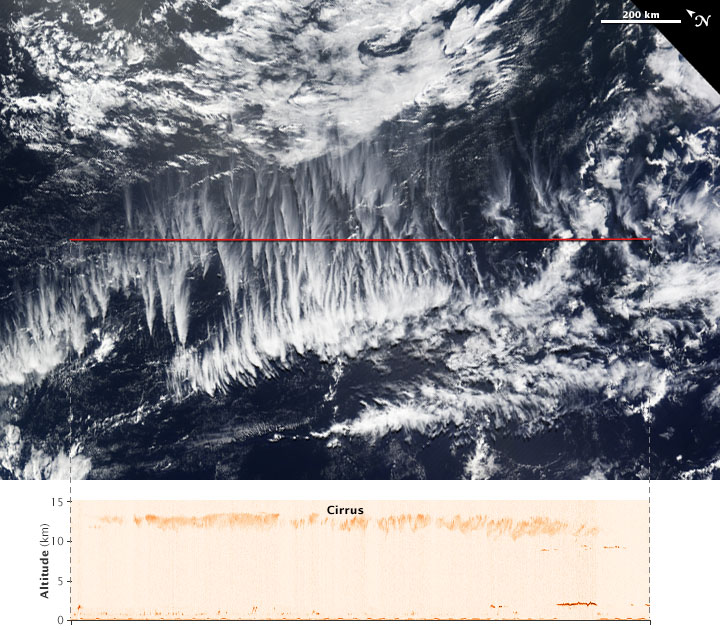


Cirrus—the wispy, icy clouds that form high in the atmosphere—are known to have a net warming effect on the climate. But how much? The question is hard to answer because even among cirrus clouds, there is wide variety and complexity in their structure.
The Moderate Resolution Imaging Spectroradiometer (MODIS) on NASA’s Terra satellite acquired a natural-color view of clouds over the South Pacific on April 2, 2015. Cirrus are the thinner clouds appearing to spread out from points across the center of the image.
The red line on the MODIS image shows the area scanned just hours before by the Cloud-Aerosol Transport System (CATS) onboard the International Space Station. “The space station orbit provides comprehensive coverage of the tropical and mid-latitude regions, where cirrus clouds are most prevalent,” said John Yorks, science lead of the CATS team at NASA’s Goddard Space Flight Center.
The instrument sends pulses of laser light down through the atmosphere and records the light scattered back to the instrument. The result is a less common perspective: a vertical slice through the atmosphere that shows cloud structure at various altitudes. In the image, darker red depicts where the atmosphere reflects more light, showing where clouds are optically thicker (more opaque).
“We are usually forced to make simplified assumptions and treat clouds as flat layers with only one cloud layer in a profile,” said Kerry Meyer, a cloud and aerosol scientist at NASA Goddard. “These April 2 images show that clouds can be very complex. You can see evidence of multilayer clouds in the CATS profile.”
In the images, the main layer of cirrus is between about 10 and 13 kilometers (33,000 and 43,000 feet) above the ground. At these altitudes, temperatures are low enough to form the ice crystals that compose the clouds. You can also see a thinner, slightly lower layer of cirrus; it is most noticeable on the right side. Low-level cumulus clouds span the length of the profile.
Profiles like this one are helping researchers better understand the vertical structure of clouds. Cirrus are relatively transparent compared to other cloud types. But there remains enough variation from cloud to cloud, even among cirrus, to make a difference in how much energy a cloud absorbs and scatters (the radiative effect). That can mean the difference between a cirrus cloud with a warming effect on climate and one with a more neutral effect.
NASA Earth Observatory image by Jesse Allen, using data provided by John Yorks and Matthew McGill of the Cloud-Aerosol Transport System (CATS) team. Caption by Kathryn Hansen.